Folklore and Tradition
(In Quest of Cultural History of India)
On 17th Nov. 2017 in IIC Delhi
Dr. Dikshit, Chairman Indian Archaeology Society, Dr. Sudha Satyawdi, Padma Vibhushan Prof. B B Lal, ex Director General, Archaeological Survey of India.
THEME
When we speak of folklore, the picture that comes to our mind is an image of village people sitting around bon fire in evenings and listen the stories of their past, migration, tribe heroes and other interesting stories of their past by their elders. Or Dadi Ma sitting on a charpoy outside a hut, surrounded by village children, ready with some absorbing tales that could be of valor, bravery or example of honesty, and so on. But folklore is not limited to these stories only. It is much more than that. It refers to learning or folk wisdom. This wisdom is particularly noted in folktales, folk songs and art forms preserved. Folklore contains the lofty thoughts of yore and highest metaphysical truths, normally incomprehensible to laymen, in subtle, story forms. The role played by Indian women over centuries in preserving cultural traditions alive in the form of ritual songs and symbolic painting is great and unique.
Indian sub-continent has a continuous tradition extended back to more than twelve millennia BC. This tradition is the inheritance of long evolutionary process of different cultures that emerged at different times, got refined and absorbed and finally it became the prestigious rich cultural heritage of the India. It is like a river that started flowing from Paleolithic period till today without any interruption.
Indian cultural heritage has been the product of two streams of thought and practices – first is folk traditions that belong to the oral traditions operate at folk levels, secondly those that belong to sophisticated literary traditions. Though the two are inter dependent yet the roots of the higher traditions lie in the little traditions.
The proposed Seminar is an effort to explore the roots of cultural heritage of India with emphasis on ‘oral tradition’. It is unfortunate that under the pressure of globalization and modernization, our rich heritage is getting corroded/ is being forsaken. Folk and oral tradition has to be kept alive otherwise oral traditions would be lost. Efforts should be made to preserve and document this invaluable fading cultural heritage. I hope this meeting would be useful.
“Dr. Sudha Satyawadi”
SPEAKERS AND CONTRIBUTORS
| 1 |
Dr. R. S. Bisht |
Joint Director General (Retd.)
ASI &. Padma Vibhushan Awardee, 2013. |
Archaeology and folklore |
| 2 |
Dr. Giriraj Kumar |
Secretary General, Rock Art Society of India | Rock Art: Perspectives of Cognitive Development and Perception of Reality of our Stone Age Ancestors. |
| 3 |
Dr. Minakshi D Pathak |
Rock Art Researcher and Artist | Living Heritage of Central Indian Rock Art |
| 4 |
Dr. Shashi Tiwari |
Secretary General, WAVES | Sapta Sindhu -The Homeland of Rigvedic Culture – Literary Evidence |
| 5 |
Dr. V.Shinde |
Vice-Chancellor, Deccan College, Pune | Continuity of Harappan Legacy over Time |
| 6 |
Dr. B. R. Mani |
Director General , National Museum | Indian Folk Traditions and Early Terracotta Art |
| 7 |
Dr. Mrugendra Nilnath Vinod |
Researcher, Archaeological studies of Sarasvati paleo-channel and Harappan civilization. | Identifying Unicorn and Cult objects in Harappan Seals |
| 8 |
Dr. D.P. Sharma |
Archaeologist, Museologist and Art Historian | Harappan Art and Symbols – New discoveries |
| 9 |
Dr.Arundhati Banerji |
Superintending Archaeologist Rtd ASI | Folk Elements in Terracotta Art |
| 10 |
Dr. R. C. Agrawal |
President, Rock Art Society of India. | Jataka Kathas and their Depiction in Ajanta paintings |
| 11 |
Dr. Shashibala |
Dean, Centre for Indology, Bharatiya Vidya Bhavan | Strolling Minstrels: Artists Transmitting Philosophical Ideas and Ideals in Folk Style in Asian Countries |
| 12 |
Dr. Shailaja Chandra |
Senior Civil Servant & Senior Visiting Fellow, Shiv Nadar University | Status of Indian Medicine and Folk Healing |
| 13 |
Prof. Molly Kaushal |
Head, Janapada Sampada Division of India Gandhi National Centre for the Arts. | Living Heritage of the Epics |
| 14 |
Dr. Anjali Capila |
Associate Professor, Lady Irwin College, New Delhi. | Folk Songs of Women of Garhwal Himalaya |
| 15 |
Ms. Neera Misra |
Chairperson, Draupadi Trust | Folklore in Audio-Visual Mass Communications and Entertainment |
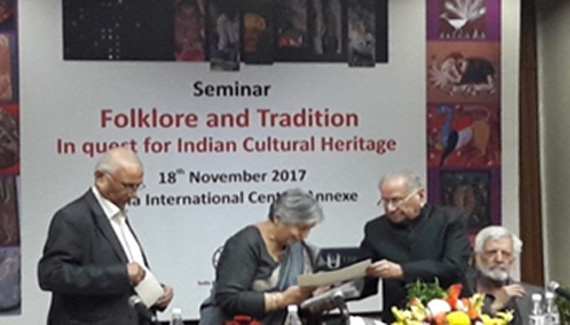
Prof B B Lal Giving Prestigious Ranaday Award to Dr. Sudha Satyawadi
‘Before inaugurating the seminar on “Folklore and Tradition”, I would like to congratulate Dr Sudha Satyawadi on her winning Gurudeva Ranade Award for her book, ‘Timeless Art of Ajanta’. According to the Expert Committee appointed by the Indian Archaeological Society, this book was assessed as the best in the field of art and archeology published during the period 2011- 15. Ever since the discovery of the Ajanta paintings, many a book has been written on these marvellous murals, and one would wonder “Why yet another book?” However, it needs to be emphasized that well-written and profusely illustrated Satyawadi’s book adds new dimensions to our knowledge of the Ajanta paintings.’
Prof. B B Lal
KEY NOTE BY PROF. B.B. LAL
Way back in the third millennium Bce, there were four major civilizations on the Afro-Asian continents: the Egyptian civilization on the banks of the Nile, the Mesopotamian civilization in the Euphrates Valley, the Chinese civilization on the Yellow River and the Indian civilization on the Indus, running up to the Sarasvati . All these civilizations were great in their own way. The Egyptian civilization is known for its pyramids. Unfortunately, during the construction of these pyramids, hundreds of laborers perished. So you have the greatness of the pyramids but accompanied by the human tragedy. In the Mesopotamian civilization, you have got royal tombs in which along with the king the retinue was also buried, and those people were poisoned so that they could not resist being forced into the burial. In the Chinese civilization, the king took delight in having a large army of soldiers and so we have the gallery of soldiers, 60,000 of them there.
The Indian (Haṛappan) civilization, on the other hand, had none of these trappings. It didn’t claim to have anything like the pyramid; it had no royal tombs, in which the followers were buried. There were no armies like the Chinese. The greatness of the Haṛappan civilization is in its egalitarian character. It was a thoroughly peaceful society. In it there flourished what may be called the art of the elites or the “high art” as well as the folk art or the art of the common man, through which folk stories were depicted.
I would like to illustrate the Haṛappan “high art” by taking three examples. On Pl. 1.1 is seen the famous bronze figure of a “dancing girl” from Mohe jo- Daṛo. It was produced with a highly advanced technique, known as cire perdu. Only about 11 cm in height, it depicts the various features vividly. She is naked and stands relaxed. The flexed right hand is placed on the right hip, while the left hand, bedecked with a series of bangles, rests on the left knee. She wears a necklace the pendant of which dangles between the breasts. The face is lifted, as if in a haughty attitude. The hair is curly and tied in a bunch at the back of the head. Of the two legs, the right is somewhat straight, while the left is bent. The feet are missing, However, in another example, which unfortunately is incomplete, there are anklets (payala) around the feet. Thus, if we visualize the two specimens together, our first figure perhaps also wore anklets – an ornament usually worn by “dancing girls.”
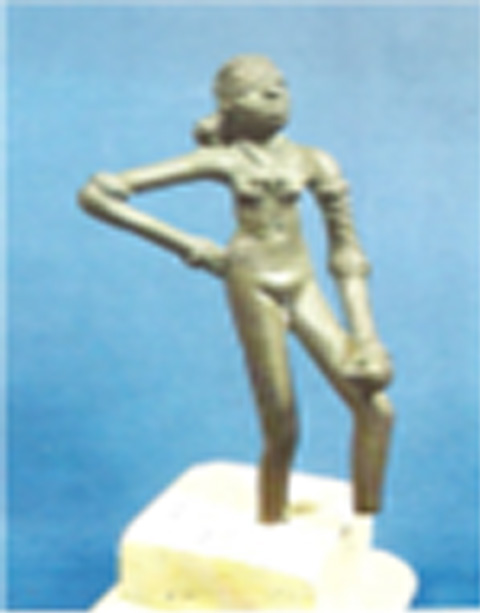
Mohe jo-Daṛo, “Dancing Girl” in Bronze
On image below may be seen the limestone figure of a “priest,” which is very finely carved. He wears a trefoil-decorated shawl which goes under the right armpit, and thence to the top of the left arm. His eyes are half-closed, indicating that he is in meditative mode. According to the prescribed method of meditation, the person must fix his gaze on the tip of the nose (n sik gra), as a result of which the eyes automatically get half-closed.
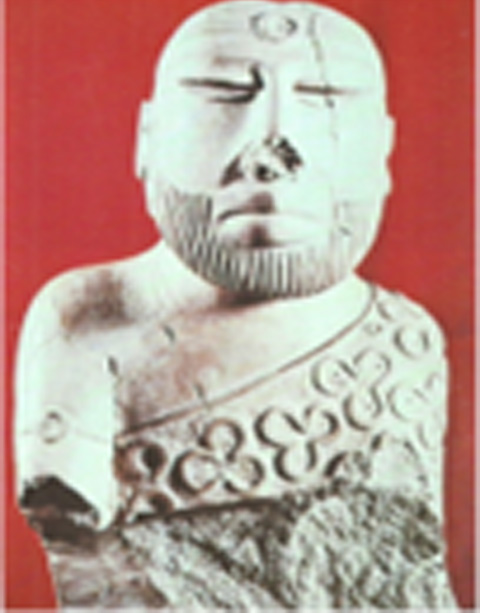
Mohe jo-Daṛo: Limestone Figure Of a “Priest”
The Haṛappan civilization is renowned for its excellently carved seals, the like of which we do not have anywhere in the world. Here we show on Pl. 1.3 the impression of a seal, generally called “Siva-Pasupati” seal. The central figure, seated in a Yogic posture, has been taken to be that of Siva. He is surrounded, clock-wise, by a tiger, an elephant, a rhinoceros and a bull. It is because of these animals that he is regarded as Pasupati (Lord of Animals).
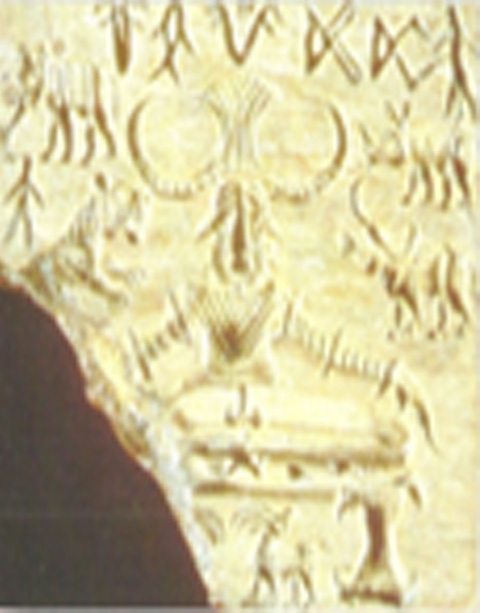
Mohe jo-Daṛo: Seal impression, depicting “Siva-Pasupati”
As against the foregoing examples of “high art,” we may now have a look at two examples of the common man’s art which may well be called “folk art.”
In this imasge, is shown a painted pot from Lothal, the renowned Haṛappan site in Gujarat. The painting portrays a well-known folk story, namely that of “The Thirsty Crow.” It’s a folk story which even today the grandmothers narrate to their grandchildren when putting them to sleep at bed time. In the picture the principal characters are a deer and a crow, with a pitcher between them. The deer wanted to drink water from the pot, but he couldn’t insert his head into it because of the long horns; so he had to walk away disappointed. Then came a crow who found that the water table in the pot was very low. The intelligent crow collected some small pebbles from nearby and started putting them inside the pot. (The painting also shows some pebbles inside the pot.) As a result, the level of the water rose, and the crow drank it to his heart’s content. Stunned by the intelligence of the crow, the deer looked back with amazement.
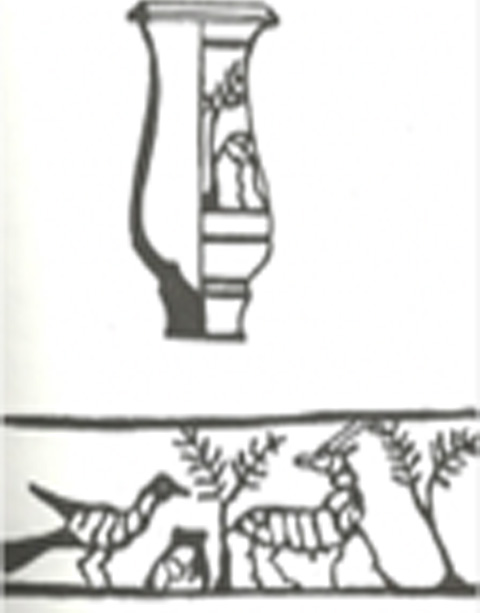
Painting On a Pot From Lothal, Depicting The Story of “The Thirsty Crow”
There is another painting from Lothal which narrates the story of the “The Cunning Fox.”
In this picture are seen two birds sitting on the branches of a tree, each holding a fish in its mouth. A fox is seen in the bottom-left corner. The fox was hungry and thought that if she praised that these birds were great singers they would open their mouth to sing and, in the process, drop the fish. That is exactly what she did. She praised them and encouraged them to sing, as soon as they opened their mouths, the fish dropped, and the fox ran away with it. This is again an example of “folk art.”
From the foregoing examples it is clear that “high art” as well “folk art” both flourished side by side in the Haṛappan civilization.
There is yet another kind of art tradition, called “tribal art”, a form of folk art, which is available in the form of rock paintings. These occur in many parts of the country, but particularly in the mountainous regions south of the Ga g basin in Uttar Pradesh and Bihar, and in Madhya Pradesh. This art has a very wide range in time, from the Stone Age to the modern. In this context one may easily refer to the World Heritage site of Bhi mbetka . The dating of these paintings at a number of places presents a challenge since even to this day the tribals keep on making additions.
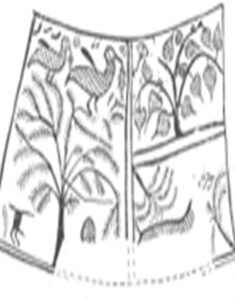
Painting On Another Pot From Lothal, Depicting The Story of “The Cunning Fox”
However, I will now refer to a case where the dating was almost a cakewalk. This is the site of Gupteshvara near Gwalior.
In early 1970s when I was a professor at the Jiwaji University, Gwalior, I undertook exploration and excavation in the Guptshvara Valley, which lies on the outskirts of the town. The excavation brought to light Lower Palaeolithic and Upper Palaeolithic tools from the open terraces. However, during the Mesolithic times the habitation pattern changed. Now the people started living in natural caves which abound in the rocks on both sides of the valley. These caves are full of paintings. I took up one of these for excavation. On the wall of the cave there were paintings in red ochre, which depicted many animals (Pl. 1.4). On the floor of the cave, there were the Mesolithic tools along with which there also occurred very small bits of ochre. The bits evidently fell on the floor while the paintings were being drawn on the wall and got mixed up with the Mesolithic tools. Thus, this was a full proof evidence,
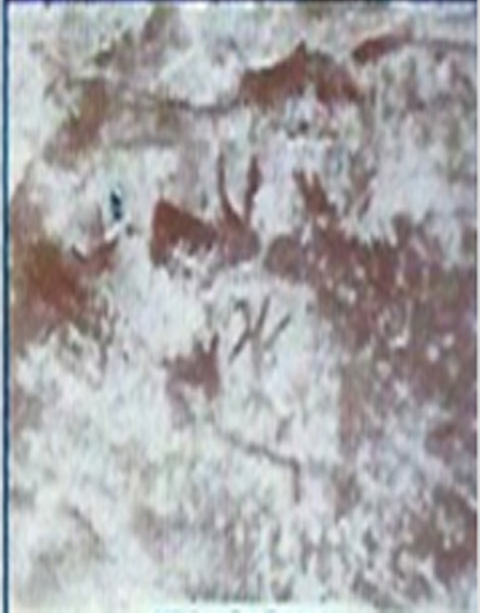
Pl. 1.4: Gupteshvara (Gwalior): Cave paintings, Mesolihic
where we can safely date the paintings to the Mesolithic times.
With these words, I have great pleasure in declaring the seminar open.
Veiwer’s Annotations
My dear Dr. Sudha Satyawadi,
You have been very kind and generous to come and invite me for your seminar on ‘Folklore, Art Forms and Oral Tradition’ held on November 18. You had gathered together many distinguished archeologists, folklorists and scholars. I wanted to attend the seminar throughout but could not do so as I was somewhat unwell. Thank you for giving the IIC members an opportunity to listen to some very eminent archaeologists and folklorists.
Kapila Vatsyayan
Scholar, Art Historian,
Ex Director IGNCA
Chairperson Asia Project IIC.
Oral tradition is a way knowledge is transmitted commonly by a group of people over many generations. Oral traditions are distinct from history from the discipline of oral history and it is transmitted and preserved in human history in the context of experiential knowledge. Thus oral tradition is not primitive preliminary technology of communication we thought it to be. It is a very important it is the single most form of dominant communicative technology of our species and it is equally a contemporary reality.
The study of our cultural heritage of oral traditions are normally relegated into the periphery. It is important that we study these important aspects these areas such as music, pottery, part three poetry, songs, painting and so on.
In fact, I think history social and political aspect should be relegated to the secondary areas. India’s continuity has been there because of oral tradition and rock art. All this is what is beyond time chronology. In these areas all people were very intelligent from the beginning itself. Thus early man had the same sense of art and also music and rhythm, it is a very important part of their existence so that there is no primitive art. It is the same impetus present then as now. The artistic urge is the same then as it is today, nothing primitive about it as the urge comes from another dimension. India’s cultural heritage is really within that area. I would like to mention that cultural heritage volume of India was brought out by Ramakrishna Mission edited by Dr Kapila Vatsyayan that emphasizes the importance of the interrelatedness between the folklore and so-called textual traditions. The emphasis on economics and technology need not be there. The continuity of the civilization which has continued for thousands of years because of this and this is where India requires an experiential knowledge. This is why this seminar is very important and needs to be brought into focus again and again. India is the living tradition in which continuity has been shown in the form of painting, pottery and other lifestyle. I think this is very important seminar to show the major aspects of Indian civilization whereby there is continuity.
Prof. S.C. Malik
Thank you for inviting me to the interesting seminar you organized. I was happy to note varied topics you had chosen for discussion. Ye, it should be published and we all will co-operate.
Prof. Vasant Shinde
Vice-Chancellor
Deccan College
Post-Graduate and Research Institute
Deemed to be University
Pune – 411 006
The Folk Lore Conference organised by you was a great success. All the speakers were eminent scholars of their field. The conference explored the journey of our folk lore tradition right from the beginning of the Stone Age in India through the Harappan culture and early historical period to the present day societies. This beautiful travel was presented thoruh rock art, archaeological remains and the lively folk songs and traditions in the tribals of Himachal Pradesh, Northeast India and central India. It was a sweet learning for me. The dignified presence of Prof B. B. Lal and Dr Kapila Vatsyayan made the conference memorable. My hearty congratulations to receive the Gurudev Ranade Award in the conference with the hands of Prof B. B. Lal. I am highly impressed by the virtues of Gurudev Ranade narrated on the occasion and your contributions in the filed of Folk Lore Traditions. The arrangements made were perfect and all the participants were facilitated and treated affectionately. Bravo for the grand success of the Congress.
Giriraj Kumar
Prof. Giriraj Kumar
Prof in Rock Art Science and Indian Culture, Secretary General, Rock Art Society of India
Thanks for inviting in conference.
Attending scholars were highly reputed so it was very refreshing experience.
You are permitted to publish my paper. It is my pleasure.
Shashi Tiwari
Secretary General, WAVES,
I must say that the conference was a great success. The papers covered a wide range of topics and were so interesting that I did not go to any of the other two conferences going on simultaneously at the IIC.
Shashibala
Dean, Centre for Indology, Bharatiya Vidya Bhavan
Thank you for the invite to your Seminar and Congratulations for a very successful one. It was enriching and some papers were inspiring as well. Hearty Congratulations on receiving the award. It was a suitable acknowledgement of the intense hard work you have put in for years as a scholar and Art Historian. So proud to know you.
Thanks again for inviting us.
With regards,
Ratna Lahiri
Academician
I want to thank you for the opportunity to be a distinguished speaker at the seminar on Folklore and Indian Cultural heritage
The seminar had excellent presentations on a variety of topics
The energy was dynamic and I thoroughly enjoyed my presentation
It was meticulously organised
Dr Anjali Capila
Associate Professor, Lady Irwin College, New Delhi.

